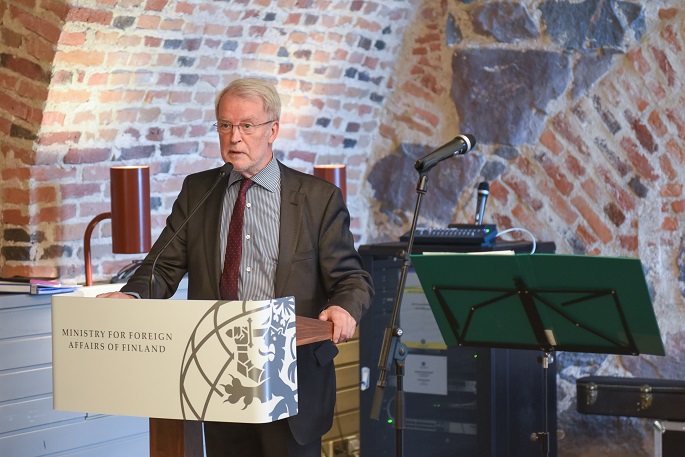Aleksi Härkönen talks to Xinhua in an exclusive interview
Understanding of climate change top concern in Arctic
Published : 27 Nov 2017, 23:18
Updated : 27 Nov 2017, 23:27
While the vision of accelerated development in the Arctic region is close at hand, Finland's Arctic ambassador Aleksi Härkönen said Monday the biggest challenges concerning the international cooperation on Arctic issues were related to the climate change.
In an interview with Xinhua, he described the challenge was in "how to make the Arctic perspectives better known in the global efforts to mitigate climate change, how to help the Arctic inhabitants adapt to the expected changes, and how to make the Arctic communities more resilient to meet the challenges posed by the warming climate".
Climate change is a global issue, but it is most greatly felt in the Arctic, noted Härkönen. For example, the excessive emissions originating from the rest of the world not only cause local pollution, but also cause atmospheric pollution in the Arctic region when the black carbon falls on snow and ice, accelerating melting, and absorbing sunlight, therefore, warming the climate, he elaborated.
Finland took over the chairmanship of the Arctic Council from the United States as of May 2017, and has adopted two issues as its main tasks: the first is climate change, and the other is sustainable development, said Härkönen.
FINANCIAL GAP
During the two-year term that Finland is chairing the Arctic Council, the Nordic country wants to harmonize the policies of the Arctic countries with the Paris Agreement reached among the international community two years ago.
The agreement has amounted to a guidebook, and the guidebook is most appreciated in the Arctic as climate change has affected this region in particular.
Härkönen recalled the happy moment when the government led by former U.S. president Barack Obama made efforts to encourage Arctic countries to contribute to the action against climate change, but worried about Washington withdrawing from the Paris agreement and causing a deficit in funding climate policies.
"If one big party leaves, that will leave the others with obligation to fill the gap," he said.
Härkönen expected most countries, including China and European Union (EU) member states, would stay and shoulder the mission to fight climate change. "The biggest of them is the People's Republic of China. And of course this would offer China an opportunity to become a leading proponent of the actions against climate change," he said.
EFFORTS NEEDED
Finland works to see how the Sustainable Development Goals (SDGs) required in the UN Agenda 2030 could be best applied in the Arctic region. As part of the Arctic Council program, a conference was organized in Rovaniemi, northern Finland, in mid-November by regional politicians, city planners, university researchers, and business elites to discuss the application of SDGs in the Arctic.
The conference was the first occasion when the SDGs in the Arctic were discussed, said Härkönen, and it chose environmental protection and education as the two main topics under the theme of sustainable development.
Any development should be sustainable, which means that the environment is well protected against any type of pollutions such as microplastics, black carbon and acidification of oceans, noted Härkönen.
Education was also underlined, considering "the Arctic region should not be developed so that the workforce is brought in from outside and then taken back, leaving the local inhabitants without employment," he added.
There are remote communities in the Arctic region where it is difficult to get a good education, and modern technical solutions such as e-learning would be helpful in such cases.
ECONOMIC VIABILITY
The past a few years have witnessed increasing traffic in the Arctic Ocean, due to the longer ice-free period in the summer. Another reason was the natural gas production project on the Yamal peninsula in northern Russia, and construction materials were transported there via the northeastern route.
However, Härkönen did not see economic viability so far concerning Arctic maritime transportation." Many companies have tried the northern sea routes and decided other routes are still better," he said.
Neither did he favor the exploitation of energy resources in the Arctic region as a whole, as "it is not quite sure whether it is feasible or whether it makes sense to utilize them." He believed there were other alternatives like renewable energy which would be competitive.
"We should apply precautionary principle rather than hasten to do something which may cause damage," he suggested.
Finland is working on projects to promote an Arctic Sea cable going under the Arctic Ocean from Europe to Asia, and a railway line linking the Arctic shore to the harbors in Helsinki and further to the European continent via an undersea tunnel between Helsinki and Tallinn, so as to contribute to better connectivity.
Feasibility reports are being prepared, and, if things go right, the sea cable may be the most hopeful to finalize among all the initiatives. The cable will shorten the time needed to pass information between different points in Asia and Europe, according to Härkönen.
Härkönen also praised China's Belt and Road Initiative, hailing it "a very good goal to unite the peoples of Asia and Europe".
Unlike in history, when Chinese silk, porcelain and other innovations were brought to Europe, the initiative brings more exchanges between continents via sea, air, land and the internet. It will be natural for the business world to harmonize the initiative with the strategies of the Arctic countries, said Härkönen.


